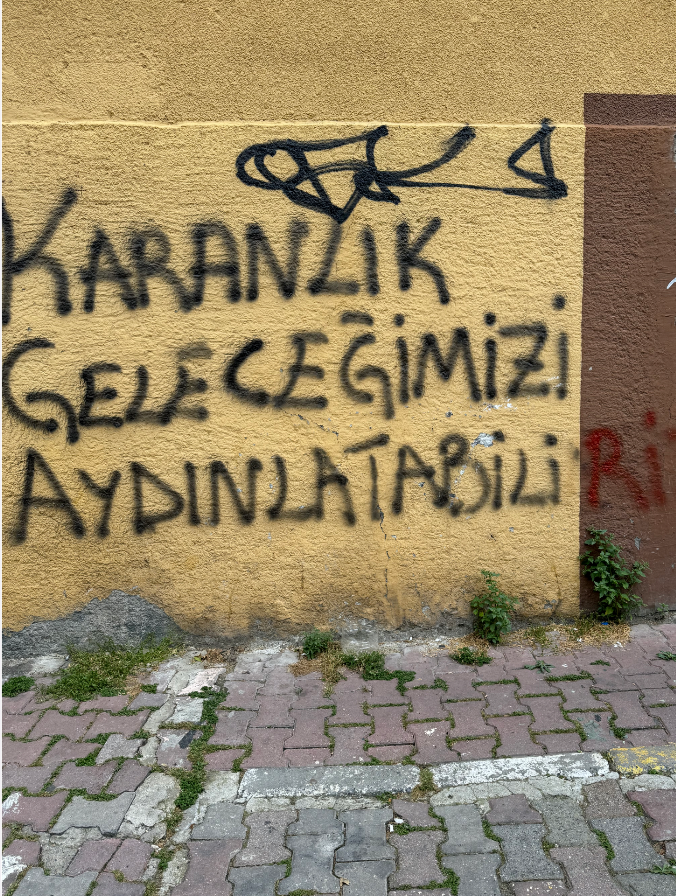Can we illuminate our dark future?


AYLİN VARTANYAN
23.5 Hrant Dink Site of Memory opened a space for participants to express the significance of April 24th through different commemoration, remembrance and arts-based practices and rituals between the 20th and 27th April. In one of these sessions, I had the opportunity to moderate a discussion with Nesim Ovadya İzrail, the author of the book titled “24 April 1915: Istanbul, Çankırı, Ayaş, Ankara” (İletişim, 2013). Following the interview, a memory walk was held under the guidance of the author. The homes of six Armenian thinkers who were taken from their homes in Istanbul and exiled to Ayaş or Çankırı on April 24, 1915 were visited. Some of those six intellectuals survived and some of them were sent to death. The idea behind conducting a silent memory walk after the discussion perhaps stemmed from a desire to create a ritualistic space, and possibly to expand our capacity to find meaning in this challenging world. 
Memorial walks, which can be described as a kind of anamnesis, require slowing down and attunement to the rhythm of the place. Walking sometimes offers an opportunity to step outside of the dictated time. When we momentarily step out of time and space, it becomes easier for us to listen to the narratives of places that carry the stories we may pass by in our daily lives. Remembering by walking in a city that bears the traces of violence from the past and permeating to the present opens a space to sense and listen to the stories that are left out by the narratives that dominate the public space and conceal the violence. In his short text titled 'Excavation and Memory ', Walter Benjamin likens the practice of memory art to archeological excavation. He presents the precision of an archaeologist while excavating, the time and dedication she spends in her work environment, and her repeated visits to the site of excavation, as a model for those interested in the art of memory. Encountering the past is not just about seeing objects unearthed from the excavation site and taken to an exhibition area. It is about encountering the genuine past facilitated by the relationship between the object and the space it occupies. On Wednesday, April 24th, alongside Nesim Ovadya İzrail, our memory walk with approximately twenty participants led us to a point where we encountered the memory of spaces where Armenian intellectuals, whose stories we have read in books and their photographs we have seen in commemorative ceremonies, once converged. As one participant noted, during our walk, "unlike official history, what happened appeared more real to us”.
Listening to the stories of writers, thinkers and artists who were taken from their homes on April 24, 1915, from an author who researched them and compiled them into a book, together with a group, in front of the houses where they once lived safely, not only removes these people from their victim status, but also reminds us that they were individuals who had their homes, their established order, their books, their lives. It also reminded us that they were individuals with spouses and families who cared for them. Especially seeing that the houses of two valuable Armenian intellectuals were side by side affected the participants in a different way. Seeing the two-story house of the poet and educator Taniel Varujan, which still survives in the brutal architecture of the city, and the house where the writer, poet and doctor Rupen Sevag once lived, which has now turned into a large and spacious apartment building, allowed us to imagine the bond between these two poets. Imagining the moment when their home visits and conversation were ruptured deepened the pain inside us. One can visualize how, once upon a time, everyday lives continued in these houses located on the main roads or in the lower streets, where much of our daily lives are spent - and of course, we can also imagine the point where that flow was broken…
The words of graffiti I encountered while walking through the same neighborhood the day before with a different purpose became a powerful expression I carried with me during the memory walk that day: "We can illuminate our dark future." As noted by trauma expert Gabor Maté, our fears about the future stem from our concern that the nightmares of past violence may also affect the future. This memory walk with a small group may have left a small but significant light on our dark future. We thank Nesim Ovadya İzrail for both speaking and guiding us through the labyrinths of our souls.



